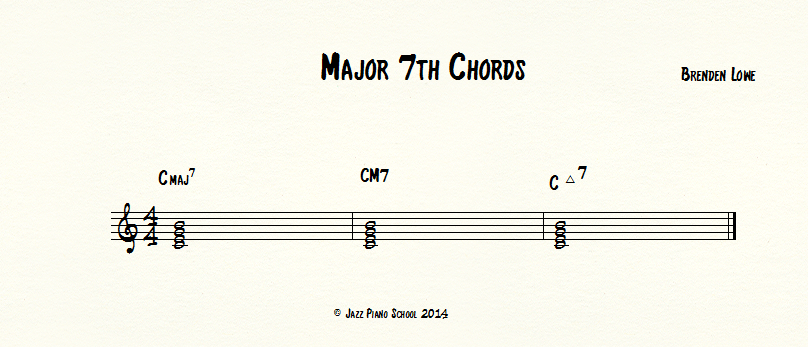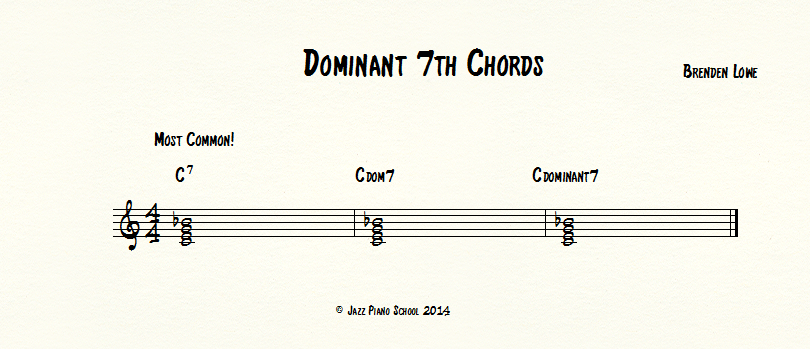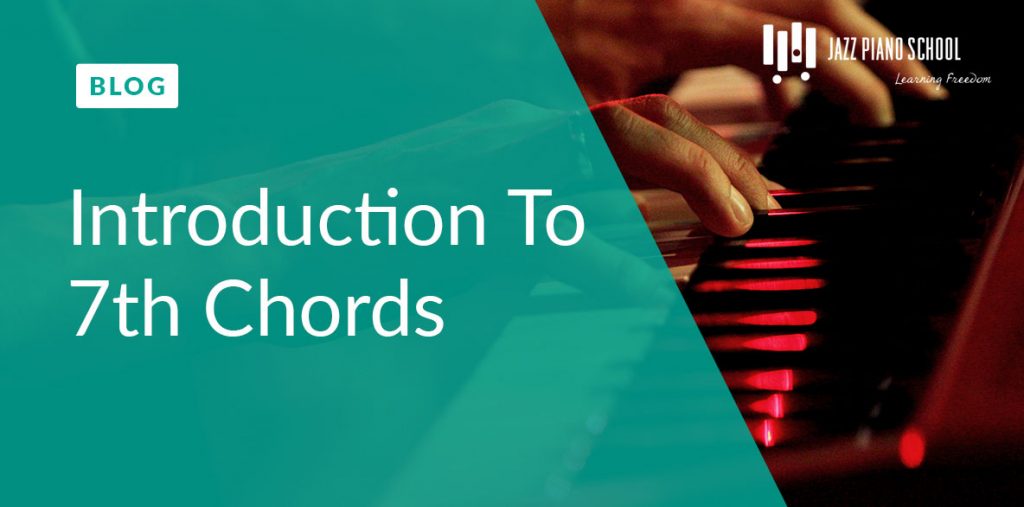Do you ever walk into a restaurant and hear someone playing the piano, and just wonder how they get those juicy jazz sounds? Or maybe you hear a song on a movie that sets the perfect kind of atmosphere for a 1950’s scene. Those harmonies (chords) that you are hearing are mainly 7th chords! And let me tell you something else, they are very easy to learn. We simply add one note to a major triad or a minor triad and we’ve got a 7th chord…no I swear I’m not kidding. This is why it is so important to learn your major and minor triads! So lets get into the three traditional ones.
Major 7th Chords
The first 7th chord I’m going to teach you is the major 7th chord. We will learn the other two after this because we will only be changing one note at a time. Yup…one note! The major 7th chord is built off of a major triad. If you’ve forgotten how to play a major triad or simply do not know how, you can read my other blog post here, How To Start Playing Pop…Major Triads. So let’s take a C major triad to build a Cmaj7th chord. We have our Cmajor triad on the bottom, the notes C, E, and G and now, all we are going to do is add the 7th degree of our C major scale. This note is B. Now we have the notes C, E, G,and B. That’s it! That is our C major7th chord. So for a major 7th chord, we are using 4 degrees from the scale 1,3,5, and 7.
All your major 7th chords will have the letter of the major triad such as C, D, or A, and then a “maj7” symbol afterwards. Cmaj7, Bbmaj7, Ebmaj7. Sometimes you will see a triangle instead of the “maj” to represent a major7th. See below for all the different symbols.

Now just a quick side note. When you see a chord symbol of “C” this already means major triad by default. So the extension “maj” before the “maj7th” is saying that we are using major7th on the top as opposed to a minor 7th on top which we will be using in our next chord. So just remember that the major is referring to the type of 7th, and not the type of triad.
Dominant 7th Chords
The dominant 7th chord is a great chord in jazz. It is the main chord used in the blues and is a chord that you have a lot of flexibility to add colors in the future. So when building a dominant chord we are only going to change one note. That note is the major 7th we used in our last chord. We are going to change the major 7th to a minor 7th. We simply flat the note and lower it a half step and have come to the note Bb in this case. Now we have a dominant 7th chord! We have a major triad on the bottom and a flat 7 on the top of the triad. Now you’ll notice the way we represent this chord through symbols is a little different. We do not use “min” or a “-” to represent the minor 7. By just adding a “7” alone to any letter such as “C” we already know it is a flat 7. This is because in our major 7th chord we specify the 7th is major. When we are not specifying a major 7th then we know its going to be a flat 7. Again, we just use the number “7” to represent the flat 7. So all dominant chords will look like this C7, A7, E7 and so on.

Minor 7th Chords
The last chord of the day will be the minor 7th chord. From our last chord we learned, the dominant 7th chord, we are only going to change one note again to create a minor 7th chord. Now in this instance the minor is referring to the triad in the chord not the 7th. So we have a minor triad on the bottom, with a flat 7th on top. So let’s say we start with a dominant 7th chord, we have the notes C, E, G, and Bb. Now in order to make a C- triad on the bottom we simply have to change the note E to an Eb and we have a minor triad. Now we have created a minor 7th chord by putting a minor triad on the bottom. So for our C-7 chord we have the notes C, Eb, G, and Bb.
Again take note that for a minor 7th chord the minor is describing the triad on the bottom so a more clear version of the symbol might look like this (C-)(7th).
If you enjoyed this article I would really appreciate if you share it or like it. Or simply like our faceboook page! Any sort of like would be greatly appreciated!
Happy Practicing!
[Tweet “This blog post is great! Check it out. #jazzpiano #jazzpianoschool”]
(Note: Do you want to start learning more about jazz piano in a way that’s organized and structured? Are you looking for a starting point? If so, check out our FREE beginner guidebook to get the scoop!)













